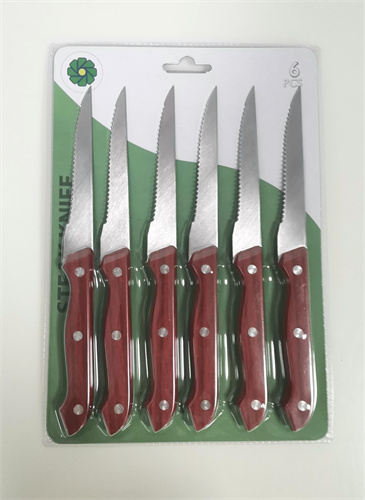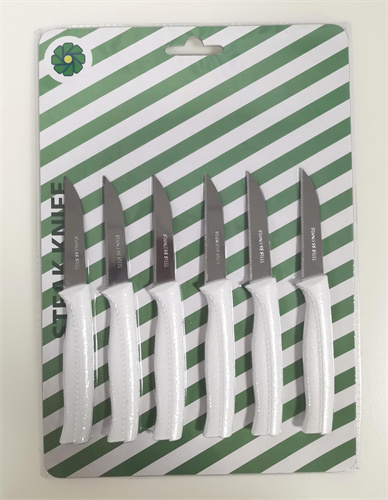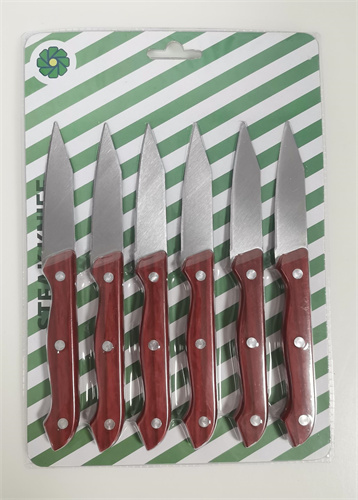

Views: 6780 Author: sales@insightknife.com.cn Publish Time: 2024-12-17 Origin: Site








Content Menu
● Understanding Blade Materials
>> The Importance of Blade Material
>> Characteristics of Stainless Steel
>> Performance of Stainless Steel Knives
>> Characteristics of High-Carbon Steel
>> Performance of High-Carbon Steel Knives
>> Maintenance of High-Carbon Steel
● Ceramic
>> Characteristics of Ceramic Blades
>> Performance of Ceramic Knives
>> Limitations of Ceramic Knives
>> Characteristics of Damascus Steel
>> Performance of Damascus Steel Knives
● Frequently Asked Questions regarding Steak Knife
>> 1. What is the best material for steak knives?
>> 2. How often should I sharpen my steak knives?
>> 3. Can I use my steak knives for other types of food?
>> 4. How do I care for high-carbon steel steak knives?
>> 5. Are ceramic steak knives worth the investment?
Steak knives are essential tools in any dining experience, particularly when it comes to enjoying a perfectly cooked steak. The performance of these knives is significantly influenced by the materials used in their blades. This article delves into the various blade materials available for steak knives, examining how each affects cutting performance, durability, maintenance, and overall user experience.
The blade material of a steak knife is crucial for its performance. Different materials offer varying levels of sharpness, edge retention, corrosion resistance, and ease of maintenance. Understanding these properties can help consumers make informed choices when selecting steak knives. The right blade material can enhance the dining experience by ensuring that the knife performs well, allowing for clean cuts and a more enjoyable meal. Additionally, the choice of material can reflect personal style and preferences, making it an important consideration for both home cooks and professional chefs.
Steak knives are typically made from several types of materials, each with its unique characteristics. The most common materials include stainless steel, high-carbon steel, ceramic, and Damascus steel. Each of these materials has its own set of advantages and disadvantages, which can affect not only the knife's performance but also its longevity and maintenance requirements. By exploring these materials in detail, consumers can better understand which type of steak knife will best suit their needs and preferences.
Stainless steel is one of the most popular materials for steak knives due to its excellent corrosion resistance and durability. It is an alloy that contains chromium, which helps prevent rust and staining. This makes stainless steel knives ideal for everyday use, as they require less maintenance compared to other materials. The ability to resist corrosion means that stainless steel knives can be used in various environments, including those with high humidity or exposure to moisture, without the fear of deterioration. Furthermore, stainless steel is often available in various grades, allowing consumers to choose a quality that fits their budget and usage needs.
Stainless steel knives can maintain a sharp edge for a reasonable amount of time, but they may not hold their sharpness as long as high-carbon steel knives. However, they are easier to sharpen and maintain, making them a practical choice for many households. The ease of sharpening is particularly beneficial for those who may not have extensive knife maintenance experience. Additionally, stainless steel knives often come with ergonomic handles, enhancing comfort during use and making them suitable for extended dining experiences.
There are various grades of stainless steel, with some being better suited for knife making than others. For instance, high-carbon stainless steel combines the benefits of both high-carbon and stainless steel, offering improved edge retention while still resisting corrosion. This hybrid material is increasingly popular among knife manufacturers, as it provides a balance between performance and maintenance. Understanding the differences between these grades can help consumers select knives that not only look good but also perform exceptionally well in the kitchen.

High-carbon steel is known for its ability to achieve a very sharp edge and maintain it for an extended period. This material is less resistant to corrosion compared to stainless steel, which means it requires more care and maintenance to prevent rust. The high carbon content in these blades contributes to their hardness, allowing them to be honed to a fine edge that can slice through meat with precision. However, this hardness can also make the blades more susceptible to chipping if not handled properly, which is an important consideration for users.
Knives made from high-carbon steel are favored by many chefs and culinary enthusiasts for their superior cutting performance. They can slice through meat with ease, making them ideal for steak. The sharpness and edge retention of high-carbon steel knives can significantly enhance the dining experience, allowing for clean cuts that preserve the integrity of the meat. However, users must be diligent about cleaning and drying these knives after use to prevent rusting. This level of care can be a drawback for some, but for those who appreciate the performance benefits, the effort is often worth it.
To maintain high-carbon steel knives, regular oiling and proper storage are essential. Users should avoid leaving these knives in damp environments and should clean them immediately after use to preserve their performance. Additionally, using a wooden or plastic cutting board can help protect the blade's edge from damage. For those who are willing to invest the time and effort into maintenance, high-carbon steel knives can provide exceptional performance and longevity, making them a favorite among serious cooks.
Ceramic blades are made from zirconium oxide, a material known for its hardness and ability to maintain a sharp edge. These knives are lightweight and resistant to corrosion, making them an attractive option for many consumers. The lightweight nature of ceramic knives can reduce hand fatigue during prolonged use, making them ideal for those who frequently prepare meals. Additionally, the non-reactive nature of ceramic means that these knives will not impart any flavors or odors to the food, preserving the integrity of the dish.
Ceramic knives can slice through meat with precision, but they are more brittle than metal knives. This brittleness means that they can chip or break if dropped or used improperly. While they maintain their sharpness longer than many steel knives, they cannot be sharpened easily and may require professional sharpening. This limitation can be a significant drawback for users who prefer to maintain their knives at home. However, for those who prioritize sharpness and ease of use, ceramic knives can be an excellent choice for specific tasks.
Ceramic knives are not suitable for all tasks. They are best used for slicing rather than chopping or prying. Additionally, their fragility can be a drawback in a busy kitchen environment. Users should be cautious when using ceramic knives, ensuring they are not subjected to excessive force or impact. Despite these limitations, ceramic knives can be a valuable addition to a knife collection, particularly for those who appreciate their unique properties and performance in specific applications.
Damascus steel is renowned for its unique patterns and exceptional performance. It is made by layering different types of steel, which are then forged together. This process creates a blade that is not only beautiful but also incredibly strong and durable. The intricate patterns formed during the forging process not only enhance the aesthetic appeal of the knife but also contribute to its performance characteristics. The combination of different steels allows for a balance of hardness and flexibility, making Damascus steel knives both functional and visually striking.
Damascus steel knives offer excellent edge retention and cutting performance. They can slice through steak effortlessly, making them a favorite among culinary professionals. The combination of different steels also provides a balance of hardness and toughness, reducing the risk of chipping or breaking. This versatility makes Damascus steel knives suitable for a variety of tasks, from slicing meat to preparing vegetables. Additionally, the unique patterns on the blade can serve as a conversation starter at the dining table, adding an element of sophistication to any meal.
In addition to their performance, Damascus steel knives are often considered works of art. The distinctive patterns on the blade make them visually appealing, adding an element of elegance to any dining experience. Many consumers appreciate the craftsmanship that goes into creating these knives, making them a popular choice for gifts and special occasions. The beauty of Damascus steel can elevate the presentation of a meal, making it not just a culinary experience but also a visual one.

When it comes to edge retention, high-carbon steel and Damascus steel generally outperform stainless steel and ceramic. High-carbon steel can maintain a sharp edge for longer periods, while Damascus steel combines the benefits of multiple steels for superior performance. This means that for those who prioritize cutting efficiency, investing in high-carbon or Damascus steel knives can lead to a more enjoyable cooking and dining experience. The ability to maintain a sharp edge reduces the frequency of sharpening, allowing users to focus on their culinary creations rather than knife maintenance.
Stainless steel is the clear winner in terms of corrosion resistance. High-carbon steel requires more maintenance to prevent rust, while ceramic blades are resistant to corrosion but can be brittle. For users who live in humid environments or who may not have the time to dedicate to knife care, stainless steel knives are often the most practical choice. Understanding the trade-offs between corrosion resistance and performance can help consumers select knives that align with their lifestyle and cooking habits.
Stainless steel knives are the easiest to maintain, requiring minimal care. High-carbon steel knives need regular oiling and careful cleaning, while ceramic knives may require professional sharpening. Damascus steel knives, while durable, also need proper care to maintain their appearance and performance. Consumers should consider their willingness to invest time in maintenance when selecting steak knives. For those who prefer low-maintenance options, stainless steel may be the best choice, while those who appreciate high performance may opt for high-carbon or Damascus steel despite the additional care required.
The choice of blade material significantly impacts the performance of steak knives. Stainless steel offers convenience and ease of maintenance, while high-carbon steel provides superior cutting performance at the cost of increased care requirements. Ceramic knives are lightweight and maintain sharpness but are more fragile, and Damascus steel combines beauty with exceptional performance. Understanding these differences can help consumers select the best steak knives for their needs, enhancing their dining experience.
In summary, when choosing steak knives, consider the balance between performance, maintenance, and aesthetic appeal to find the perfect fit for your culinary adventures. The right knife can transform the way you enjoy your meals, making each dining experience not only delicious but also memorable. Whether you are a casual home cook or a professional chef, investing in quality steak knives tailored to your preferences can elevate your culinary skills and enhance your enjoyment of food.

The best material for steak knives depends on personal preference and intended use. High-carbon steel is favored for its sharpness and edge retention, while stainless steel is preferred for its corrosion resistance and low maintenance. Damascus steel offers both beauty and performance, making it a popular choice among enthusiasts.
The frequency of sharpening steak knives depends on the material and usage. High-carbon steel knives may need sharpening every few months with regular use, while stainless steel knives can go longer between sharpenings. Ceramic knives typically maintain their sharpness for a longer period but may require professional sharpening when dull.
While steak knives are designed primarily for cutting meat, they can be used for other foods like vegetables and bread. However, using them for tasks like chopping or prying can damage the blade. It's best to use the appropriate knife for each task to maintain the integrity of the blade.
To care for high-carbon steel steak knives, clean them immediately after use to prevent rust. Dry them thoroughly and apply a light coat of mineral oil to protect the blade. Store them in a dry place, preferably in a knife block or magnetic strip, to avoid moisture exposure.
Ceramic steak knives can be worth the investment for those who prioritize sharpness and lightweight handling. They maintain their edge longer than many steel knives and do not rust. However, their brittleness means they require careful handling and are not suitable for all tasks, so users should consider their cooking habits before purchasing.